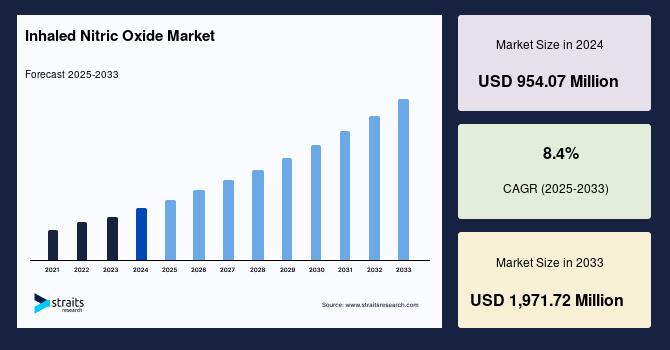Inhaled Nitric Oxide Market: Driving Growth Through Innovative Respiratory Therapies

Introduction
The global inhaled nitric oxide market size was valued at USD 954.07 Million in 2024. It is expected to reach from USD 1,034.21 Million by 2025 to USD 1,547.95 million by 2033, growing at a CAGR of 8.4% during the forecast period (2025–2033).
Market Overview
Inhaled nitric oxide acts as a selective pulmonary vasodilator, improving oxygenation by dilating blood vessels in the lungs without significantly affecting systemic blood pressure. This mechanism underpins its widespread use in the management of persistent pulmonary hypertension of the newborn (PPHN), hypoxic respiratory failure, and chronic obstructive pulmonary disease (COPD). Its clinical utility extends to treating acute respiratory distress syndrome (ARDS), neonatal respiratory distress syndrome, and other cardiopulmonary illnesses, encompassing both pediatric and adult populations.
Drivers of Market Growth
Several factors propel the inhaled nitric oxide market forward:
-
Rising Incidence of Neonatal and Pulmonary Disorders: Conditions such as PPHN affect approximately 0.4 to 6.8 per 1,000 live births, significantly contributing to newborn mortality. Hypoxic respiratory failure in neonates remains a critical challenge, boosting iNO adoption. COPD, impacting over 65 million people worldwide with a high correlation to pulmonary hypertension, further enhances market demand.
-
Technological Advancements: Innovations in nitric oxide delivery systems enable precise dosing and improved safety, facilitating increased clinical adoption. Development of portable and cylinder-free generation devices cater to both hospital and ambulatory care settings, broadening accessibility.
-
Expanding Applications and Clinical Research: Beyond traditional uses, clinical trials are exploring iNO's potential in treating ailments such as acute bronchiolitis, submassive pulmonary embolism, sickle cell disease, bronchopulmonary dysplasia, and malaria. The therapeutic scope continues to widen as evidence supporting off-label and novel indications accumulates.
Regional Market Insights
-
North America: Holding the largest market share globally, North America leads with advanced healthcare infrastructure, ongoing research investments, and significant market penetration by established players. The U.S. dominates this region, driven by government support, high prevalence of respiratory diseases, and favorable reimbursement policies.
-
Asia Pacific: The fastest-growing region due to a high birth rate and increasing prevalence of respiratory and pulmonary diseases. Emerging regional suppliers and expanding healthcare access fuel rapid market growth across China, India, and Southeast Asia.
-
Europe: Maintaining a significant share, Europe benefits from established clinical use, rising chronic disease incidence, and an aging population demanding advanced pulmonary care technologies.
-
Other Regions: Latin America, the Middle East, and Africa are witnessing gradual market expansion due to increasing healthcare investments and rising respiratory disease awareness.
Segmentation Analysis
-
By Application: Neonatal respiratory treatments are the dominant segment, accounting for a substantial portion of market revenues. The use of iNO in managing neonatal hypoxic respiratory failure continues to rise steadily.
-
By Product Type: The gas segment leads market share due to the growing preference for nitric oxide gas therapy complemented by delivery systems that ensure accurate administration.
-
By End-User: Hospitals constitute the largest end-use segment, representing the majority of iNO application owing to their critical care capabilities and extensive patient volumes requiring pulmonary therapies.
Market Challenges
Despite promising growth, certain challenges restrain market expansion:
-
High Treatment Costs: The expense incurred in administering inhaled nitric oxide is considerable, with costs running approximately $100 per hour in some regions. This financial burden limits widespread adoption in resource-constrained settings.
-
Product Recalls and Safety Concerns: Occasional recalls, such as the one by Mallinckrodt Pharmaceuticals linked to device calibration issues, can affect market confidence and adoption.
-
Logistical Barriers: The complexity of iNO delivery systems and the need for trained personnel may hinder rapid uptake, especially in low-income regions.
Future Outlook and Opportunities
The inhaled nitric oxide market is poised for sustained growth, backed by ongoing research, broadened clinical indications, and technological progress. Several opportunities lie ahead:
-
Emerging Uses: Investigations into iNO for conditions like COVID-19-related respiratory distress and other inflammatory lung disorders may unlock new revenue streams.
-
Portable and Home-Based Devices: Development of user-friendly, portable delivery systems opens avenues for outpatient and home care, improving patient convenience and compliance.
-
Strategic Collaborations: Partnerships between gas suppliers, pharmaceutical companies, and healthcare institutions are expected to accelerate innovation and market penetration.
Conclusion
Inhaled nitric oxide therapy stands as a transformative treatment modality for pulmonary and neonatal disorders with growing global acceptance. The market's projected CAGR of 8.4% until 2033 highlights robust demand fueled by expanding clinical applications, technological improvements, and rising respiratory disease prevalence worldwide. While cost and logistical challenges remain, ongoing innovations and emerging therapeutic possibilities position the inhaled nitric oxide market for substantial and sustained growth in the coming decade.
- Art
- Causes
- Crafts
- Dance
- Drinks
- Film
- Fitness
- Food
- Juegos
- Gardening
- Health
- Home
- Literature
- Music
- Networking
- Other
- Party
- Religion
- Shopping
- Sports
- Theater
- Wellness



